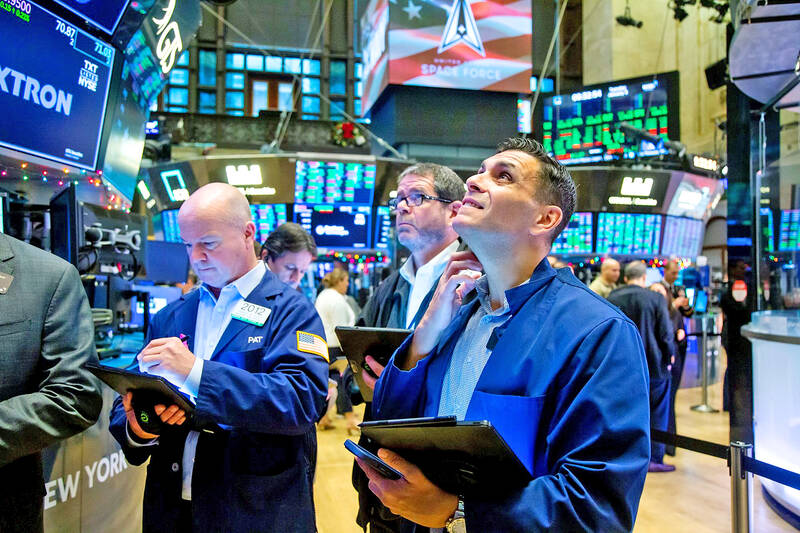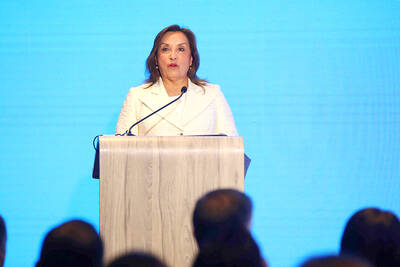More than 1,100km from Wall Street, the New York Stock Exchange’s (NYSE) backup data center on Cermak Road in Chicago is supposed to safeguard US markets, standing by at all hours in case disaster strikes the world’s largest venue for trading shares.
When markets are closed, it participates in a well-worn routine, with NYSE staffers turning on and off systems to ensure everything works.
Heading into Tuesday, an NYSE employee failed to properly shut down Cermak’s disaster-recovery system — leading to a disaster.

Photo: Bloomberg
That error, described by people with direct knowledge of NYSE’s internal operations, is what triggered wild market swings when trading opened on Tuesday in Manhattan. The chaos affected more than 250 companies including Wells Fargo & Co, McDonald’s Corp, Walmart Inc and Morgan Stanley, in some cases sending stock prices swinging by 25 percentage points in a matter of minutes.
The episode prompted the exchange to cancel thousands of trades at a cost that is still being determined. Meanwhile, market professionals and day traders are rattled and waiting for the exchange to elaborate on what it publicly called a “manual error” involving its “disaster recovery configuration.”
“They’re going to need to come up with something better” to reassure investors and regulators, said Joseph Saluzzi, a partner and cofounder of Themis Trading LLC, whose firm avoided losses.
“There’s zero tolerance” for systems failures “when it comes to the opening and the close,” he said.
The turmoil resulted because the backup system in Cermak was left running, misleading the exchange’s computers to treat the 9:30am opening bell as a continuation of trading, and so they skipped the day’s opening auctions, which neatly set initial prices, one of the people said.
Without that routine step, orders flowed through at prices all over the place. That soon tripped circuit breakers designed to prevent excessive market swings, setting off alarms on screens across the investing world.
NYSE executives spent hours pinpointing the problem until they were confident there would not be further fallout, the people said on condition of anonymity.
Officials also began reviewing whether the dislocated trades could be labeled “clearly erroneous” under the market’s rules and then canceled.
Shortly before 3pm on Tuesday, the exchange said it would unwind the most egregious transactions.
“A core value of [Intercontinental Exchange Inc] and the NYSE is our commitment to collaboration,” a spokesperson for NYSE said in a statement on Thursday. “The issues around our market open on Tuesday are our collective responsibility, and we have moved swiftly and decisively to resolve them as a team.”
NYSE has yet to determine how much the debacle may cost. It’s already fielding claims from firms under the exchange’s rules, the people said.
The venue gathers about US$500,000 per month for a fund to compensate exchange members — mostly broker-dealers representing their investor clients — when such mishaps occur. Decisions on claims for Tuesday’s episode are to be made by the end of the month.
Behind closed doors, NYSE executives are grappling not just with the potential cost, but the impact on the exchange’s reputation. They are in contact with regulators and lawmakers to explain what happened.
They plan to examine the platform’s procedures and management, potentially reworking rules to be more flexible and provide further protections.
The exchange had not determined as of late Wednesday whether anyone would face disciplinary action.

CAUTIOUS RECOVERY: While the manufacturing sector returned to growth amid the US-China trade truce, firms remain wary as uncertainty clouds the outlook, the CIER said The local manufacturing sector returned to expansion last month, as the official purchasing managers’ index (PMI) rose 2.1 points to 51.0, driven by a temporary easing in US-China trade tensions, the Chung-Hua Institution for Economic Research (CIER, 中華經濟研究院) said yesterday. The PMI gauges the health of the manufacturing industry, with readings above 50 indicating expansion and those below 50 signaling contraction. “Firms are not as pessimistic as they were in April, but they remain far from optimistic,” CIER president Lien Hsien-ming (連賢明) said at a news conference. The full impact of US tariff decisions is unlikely to become clear until later this month

With an approval rating of just two percent, Peruvian President Dina Boluarte might be the world’s most unpopular leader, according to pollsters. Protests greeted her rise to power 29 months ago, and have marked her entire term — joined by assorted scandals, investigations, controversies and a surge in gang violence. The 63-year-old is the target of a dozen probes, including for her alleged failure to declare gifts of luxury jewels and watches, a scandal inevitably dubbed “Rolexgate.” She is also under the microscope for a two-week undeclared absence for nose surgery — which she insists was medical, not cosmetic — and is

GROWING CONCERN: Some senior Trump administration officials opposed the UAE expansion over fears that another TSMC project could jeopardize its US investment Taiwan Semiconductor Manufacturing Co (TSMC, 台積電) is evaluating building an advanced production facility in the United Arab Emirates (UAE) and has discussed the possibility with officials in US President Donald Trump’s administration, people familiar with the matter said, in a potentially major bet on the Middle East that would only come to fruition with Washington’s approval. The company has had multiple meetings in the past few months with US Special Envoy to the Middle East Steve Witkoff and officials from MGX, an influential investment vehicle overseen by the UAE president’s brother, the people said. The conversations are a continuation of talks that

Alchip Technologies Ltd (世芯), an application-specific integrated circuit (ASIC) designer specializing in artificial-intelligence (AI) chips, yesterday said that small-volume production of 3-nanometer (nm) chips for a key customer is on track to start by the end of this year, dismissing speculation about delays in producing advanced chips. As Alchip is transitioning from 7-nanometer and 5-nanometer process technology to 3 nanometers, investors and shareholders have been closely monitoring whether the company is navigating through such transition smoothly. “We are proceeding well in [building] this generation [of chips]. It appears to me that no revision will be required. We have achieved success in designing